Assessment 3: Case Study of Bruce and Social Anxiety in Adolescence
VerifiedAdded on 2023/06/04
|9
|2509
|454
Case Study
AI Summary
This case study focuses on Bruce, a 16-year-old diagnosed with Autism Spectrum Disorder (ASD) and experiencing significant social anxiety. The case study details Bruce's background, presenting issues, and the assessment methods used, including the Liebowitz Social Anxiety Scale and the Spence Children Anxiety Scale, to evaluate his anxiety levels in various social situations. It analyzes his fear of judgment, avoidance behaviors, and the impact of his condition on his daily life, particularly in school and social settings. The formulation section examines the neurodevelopmental aspects of ASD and how Bruce's introverted nature and low confidence contribute to his anxiety. The diagnosis confirms ASD and highlights the genetic factors and the impact of environmental stressors on his condition. The recommendations suggest continued therapy, including language and speech therapies, and strategies to encourage Bruce to socialize and build confidence. The case study emphasizes the importance of understanding Bruce's perspective and providing support to help him overcome his challenges.
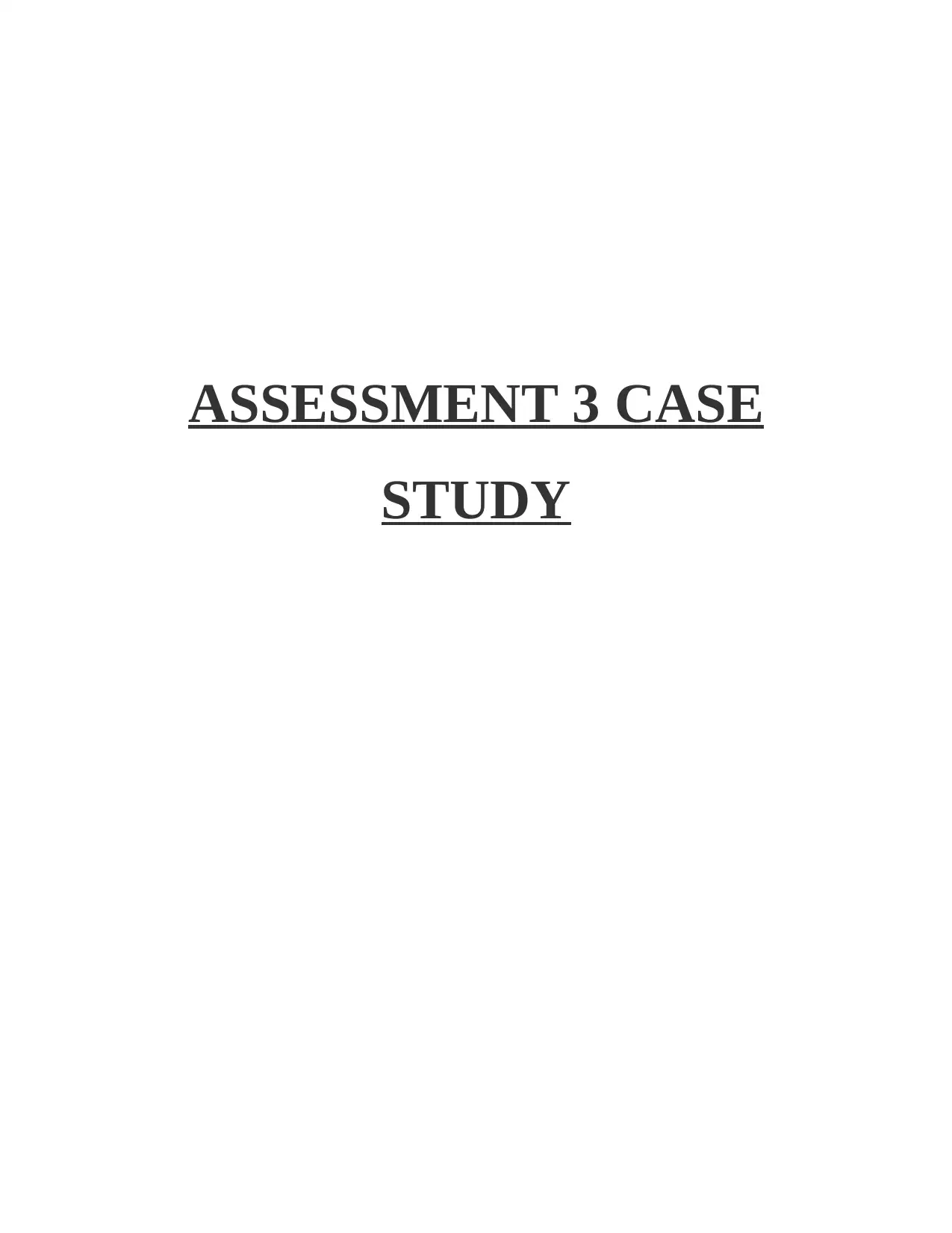
ASSESSMENT 3 CASE
STUDY
STUDY
Paraphrase This Document
Need a fresh take? Get an instant paraphrase of this document with our AI Paraphraser
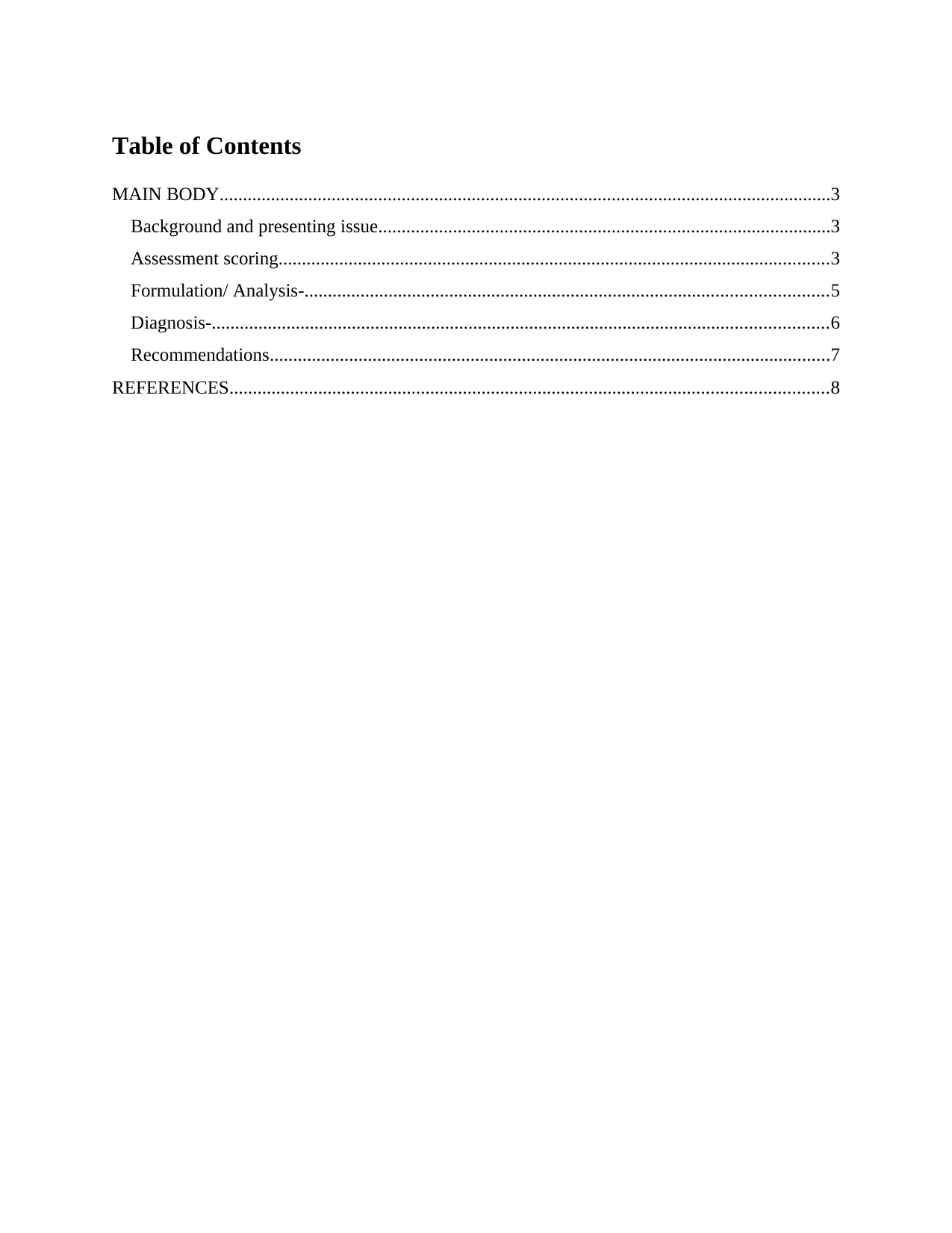
Table of Contents
MAIN BODY...................................................................................................................................3
Background and presenting issue.................................................................................................3
Assessment scoring......................................................................................................................3
Formulation/ Analysis-................................................................................................................5
Diagnosis-....................................................................................................................................6
Recommendations........................................................................................................................7
REFERENCES................................................................................................................................8
MAIN BODY...................................................................................................................................3
Background and presenting issue.................................................................................................3
Assessment scoring......................................................................................................................3
Formulation/ Analysis-................................................................................................................5
Diagnosis-....................................................................................................................................6
Recommendations........................................................................................................................7
REFERENCES................................................................................................................................8
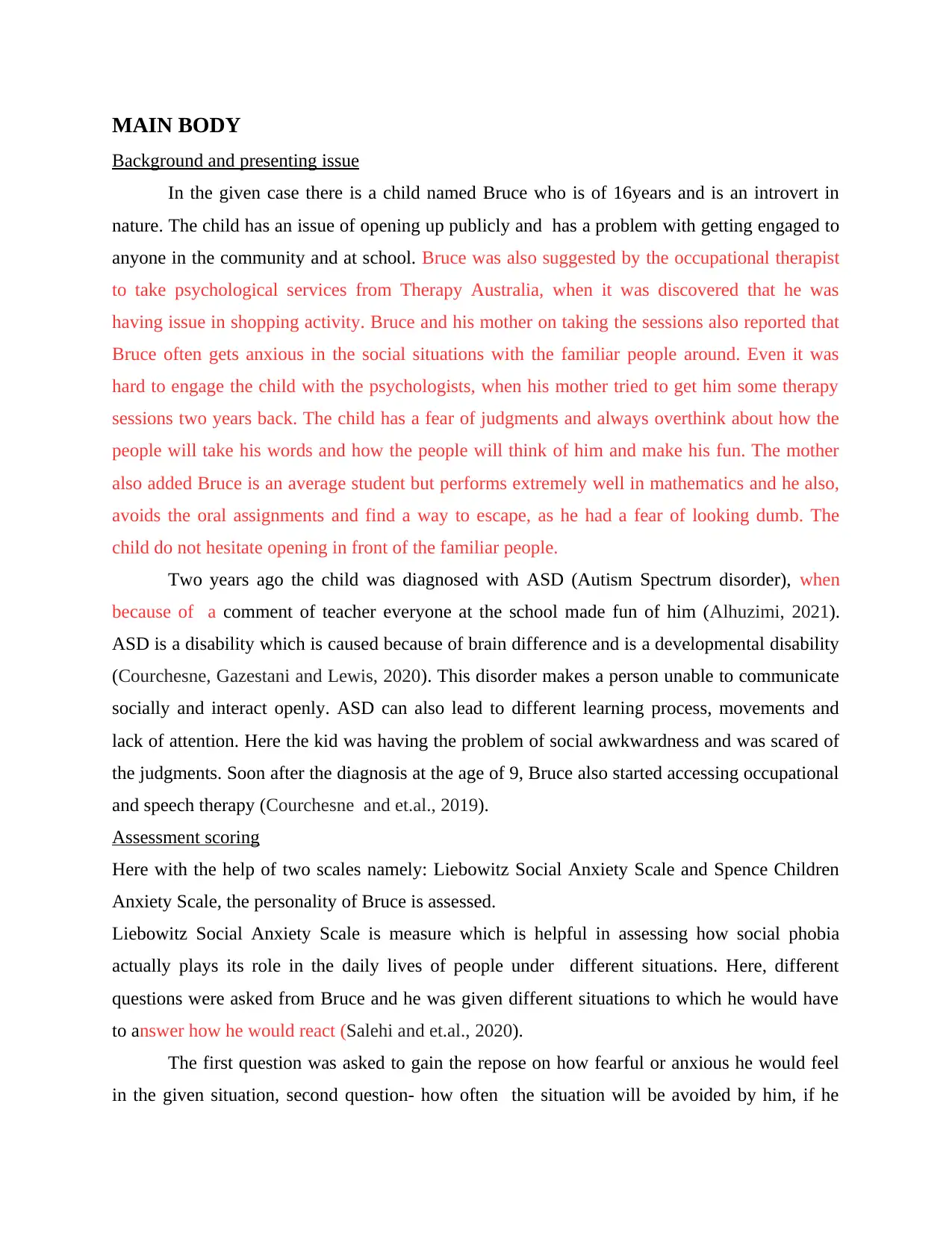
MAIN BODY
Background and presenting issue
In the given case there is a child named Bruce who is of 16years and is an introvert in
nature. The child has an issue of opening up publicly and has a problem with getting engaged to
anyone in the community and at school. Bruce was also suggested by the occupational therapist
to take psychological services from Therapy Australia, when it was discovered that he was
having issue in shopping activity. Bruce and his mother on taking the sessions also reported that
Bruce often gets anxious in the social situations with the familiar people around. Even it was
hard to engage the child with the psychologists, when his mother tried to get him some therapy
sessions two years back. The child has a fear of judgments and always overthink about how the
people will take his words and how the people will think of him and make his fun. The mother
also added Bruce is an average student but performs extremely well in mathematics and he also,
avoids the oral assignments and find a way to escape, as he had a fear of looking dumb. The
child do not hesitate opening in front of the familiar people.
Two years ago the child was diagnosed with ASD (Autism Spectrum disorder), when
because of a comment of teacher everyone at the school made fun of him (Alhuzimi, 2021).
ASD is a disability which is caused because of brain difference and is a developmental disability
(Courchesne, Gazestani and Lewis, 2020). This disorder makes a person unable to communicate
socially and interact openly. ASD can also lead to different learning process, movements and
lack of attention. Here the kid was having the problem of social awkwardness and was scared of
the judgments. Soon after the diagnosis at the age of 9, Bruce also started accessing occupational
and speech therapy (Courchesne and et.al., 2019).
Assessment scoring
Here with the help of two scales namely: Liebowitz Social Anxiety Scale and Spence Children
Anxiety Scale, the personality of Bruce is assessed.
Liebowitz Social Anxiety Scale is measure which is helpful in assessing how social phobia
actually plays its role in the daily lives of people under different situations. Here, different
questions were asked from Bruce and he was given different situations to which he would have
to answer how he would react (Salehi and et.al., 2020).
The first question was asked to gain the repose on how fearful or anxious he would feel
in the given situation, second question- how often the situation will be avoided by him, if he
Background and presenting issue
In the given case there is a child named Bruce who is of 16years and is an introvert in
nature. The child has an issue of opening up publicly and has a problem with getting engaged to
anyone in the community and at school. Bruce was also suggested by the occupational therapist
to take psychological services from Therapy Australia, when it was discovered that he was
having issue in shopping activity. Bruce and his mother on taking the sessions also reported that
Bruce often gets anxious in the social situations with the familiar people around. Even it was
hard to engage the child with the psychologists, when his mother tried to get him some therapy
sessions two years back. The child has a fear of judgments and always overthink about how the
people will take his words and how the people will think of him and make his fun. The mother
also added Bruce is an average student but performs extremely well in mathematics and he also,
avoids the oral assignments and find a way to escape, as he had a fear of looking dumb. The
child do not hesitate opening in front of the familiar people.
Two years ago the child was diagnosed with ASD (Autism Spectrum disorder), when
because of a comment of teacher everyone at the school made fun of him (Alhuzimi, 2021).
ASD is a disability which is caused because of brain difference and is a developmental disability
(Courchesne, Gazestani and Lewis, 2020). This disorder makes a person unable to communicate
socially and interact openly. ASD can also lead to different learning process, movements and
lack of attention. Here the kid was having the problem of social awkwardness and was scared of
the judgments. Soon after the diagnosis at the age of 9, Bruce also started accessing occupational
and speech therapy (Courchesne and et.al., 2019).
Assessment scoring
Here with the help of two scales namely: Liebowitz Social Anxiety Scale and Spence Children
Anxiety Scale, the personality of Bruce is assessed.
Liebowitz Social Anxiety Scale is measure which is helpful in assessing how social phobia
actually plays its role in the daily lives of people under different situations. Here, different
questions were asked from Bruce and he was given different situations to which he would have
to answer how he would react (Salehi and et.al., 2020).
The first question was asked to gain the repose on how fearful or anxious he would feel
in the given situation, second question- how often the situation will be avoided by him, if he
⊘ This is a preview!⊘
Do you want full access?
Subscribe today to unlock all pages.

Trusted by 1+ million students worldwide
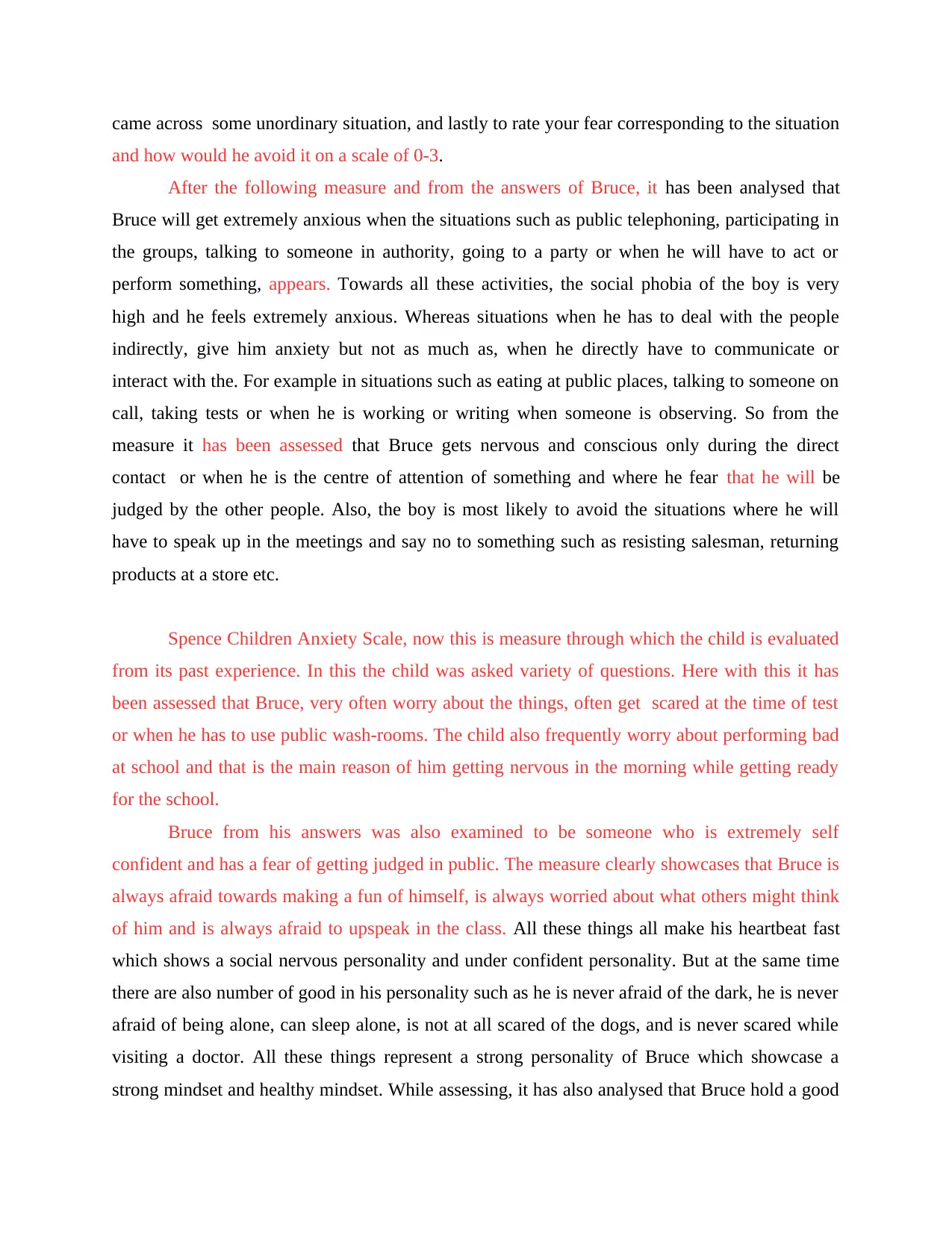
came across some unordinary situation, and lastly to rate your fear corresponding to the situation
and how would he avoid it on a scale of 0-3.
After the following measure and from the answers of Bruce, it has been analysed that
Bruce will get extremely anxious when the situations such as public telephoning, participating in
the groups, talking to someone in authority, going to a party or when he will have to act or
perform something, appears. Towards all these activities, the social phobia of the boy is very
high and he feels extremely anxious. Whereas situations when he has to deal with the people
indirectly, give him anxiety but not as much as, when he directly have to communicate or
interact with the. For example in situations such as eating at public places, talking to someone on
call, taking tests or when he is working or writing when someone is observing. So from the
measure it has been assessed that Bruce gets nervous and conscious only during the direct
contact or when he is the centre of attention of something and where he fear that he will be
judged by the other people. Also, the boy is most likely to avoid the situations where he will
have to speak up in the meetings and say no to something such as resisting salesman, returning
products at a store etc.
Spence Children Anxiety Scale, now this is measure through which the child is evaluated
from its past experience. In this the child was asked variety of questions. Here with this it has
been assessed that Bruce, very often worry about the things, often get scared at the time of test
or when he has to use public wash-rooms. The child also frequently worry about performing bad
at school and that is the main reason of him getting nervous in the morning while getting ready
for the school.
Bruce from his answers was also examined to be someone who is extremely self
confident and has a fear of getting judged in public. The measure clearly showcases that Bruce is
always afraid towards making a fun of himself, is always worried about what others might think
of him and is always afraid to upspeak in the class. All these things all make his heartbeat fast
which shows a social nervous personality and under confident personality. But at the same time
there are also number of good in his personality such as he is never afraid of the dark, he is never
afraid of being alone, can sleep alone, is not at all scared of the dogs, and is never scared while
visiting a doctor. All these things represent a strong personality of Bruce which showcase a
strong mindset and healthy mindset. While assessing, it has also analysed that Bruce hold a good
and how would he avoid it on a scale of 0-3.
After the following measure and from the answers of Bruce, it has been analysed that
Bruce will get extremely anxious when the situations such as public telephoning, participating in
the groups, talking to someone in authority, going to a party or when he will have to act or
perform something, appears. Towards all these activities, the social phobia of the boy is very
high and he feels extremely anxious. Whereas situations when he has to deal with the people
indirectly, give him anxiety but not as much as, when he directly have to communicate or
interact with the. For example in situations such as eating at public places, talking to someone on
call, taking tests or when he is working or writing when someone is observing. So from the
measure it has been assessed that Bruce gets nervous and conscious only during the direct
contact or when he is the centre of attention of something and where he fear that he will be
judged by the other people. Also, the boy is most likely to avoid the situations where he will
have to speak up in the meetings and say no to something such as resisting salesman, returning
products at a store etc.
Spence Children Anxiety Scale, now this is measure through which the child is evaluated
from its past experience. In this the child was asked variety of questions. Here with this it has
been assessed that Bruce, very often worry about the things, often get scared at the time of test
or when he has to use public wash-rooms. The child also frequently worry about performing bad
at school and that is the main reason of him getting nervous in the morning while getting ready
for the school.
Bruce from his answers was also examined to be someone who is extremely self
confident and has a fear of getting judged in public. The measure clearly showcases that Bruce is
always afraid towards making a fun of himself, is always worried about what others might think
of him and is always afraid to upspeak in the class. All these things all make his heartbeat fast
which shows a social nervous personality and under confident personality. But at the same time
there are also number of good in his personality such as he is never afraid of the dark, he is never
afraid of being alone, can sleep alone, is not at all scared of the dogs, and is never scared while
visiting a doctor. All these things represent a strong personality of Bruce which showcase a
strong mindset and healthy mindset. While assessing, it has also analysed that Bruce hold a good
Paraphrase This Document
Need a fresh take? Get an instant paraphrase of this document with our AI Paraphraser
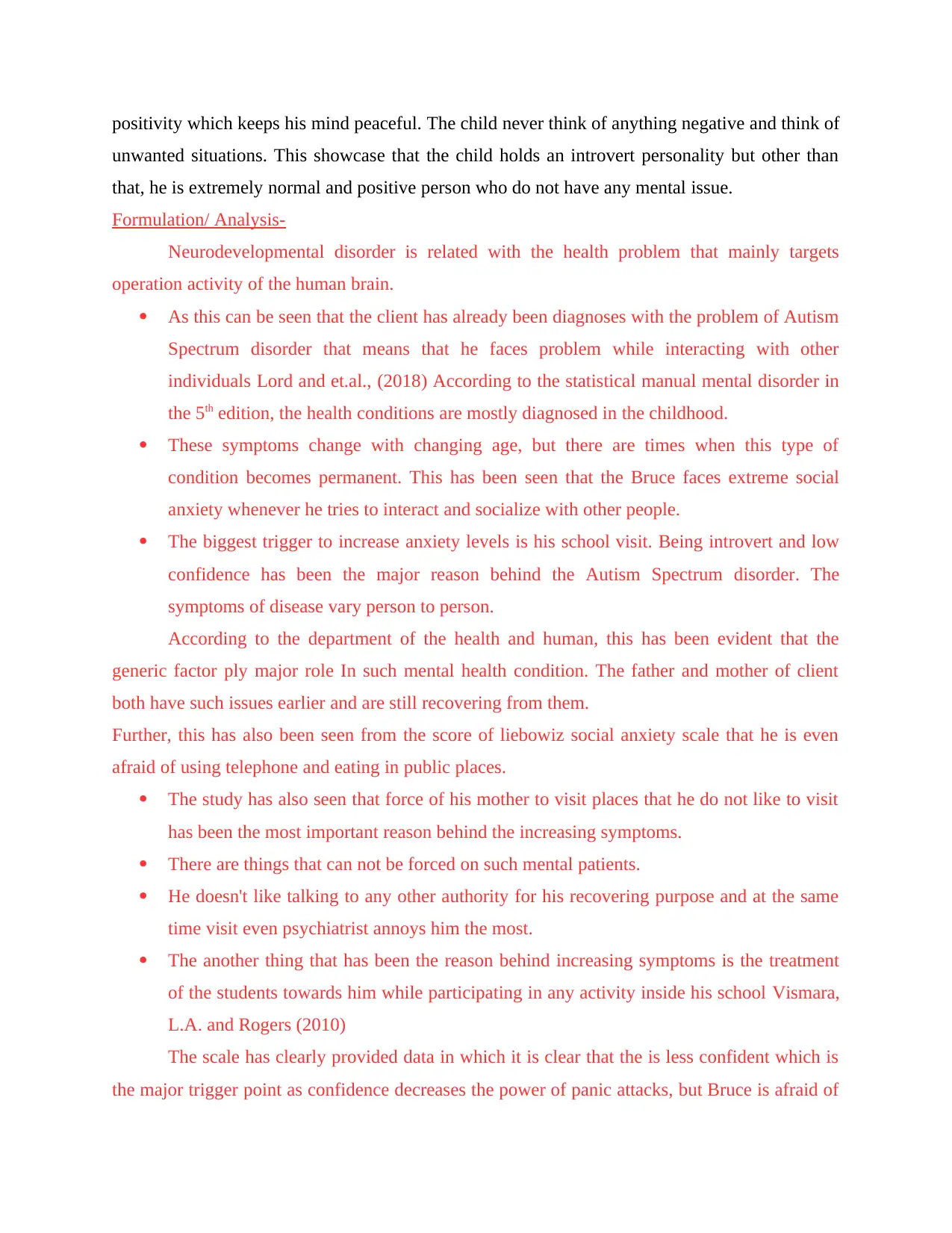
positivity which keeps his mind peaceful. The child never think of anything negative and think of
unwanted situations. This showcase that the child holds an introvert personality but other than
that, he is extremely normal and positive person who do not have any mental issue.
Formulation/ Analysis-
Neurodevelopmental disorder is related with the health problem that mainly targets
operation activity of the human brain.
As this can be seen that the client has already been diagnoses with the problem of Autism
Spectrum disorder that means that he faces problem while interacting with other
individuals Lord and et.al., (2018) According to the statistical manual mental disorder in
the 5th edition, the health conditions are mostly diagnosed in the childhood.
These symptoms change with changing age, but there are times when this type of
condition becomes permanent. This has been seen that the Bruce faces extreme social
anxiety whenever he tries to interact and socialize with other people.
The biggest trigger to increase anxiety levels is his school visit. Being introvert and low
confidence has been the major reason behind the Autism Spectrum disorder. The
symptoms of disease vary person to person.
According to the department of the health and human, this has been evident that the
generic factor ply major role In such mental health condition. The father and mother of client
both have such issues earlier and are still recovering from them.
Further, this has also been seen from the score of liebowiz social anxiety scale that he is even
afraid of using telephone and eating in public places.
The study has also seen that force of his mother to visit places that he do not like to visit
has been the most important reason behind the increasing symptoms.
There are things that can not be forced on such mental patients.
He doesn't like talking to any other authority for his recovering purpose and at the same
time visit even psychiatrist annoys him the most.
The another thing that has been the reason behind increasing symptoms is the treatment
of the students towards him while participating in any activity inside his school Vismara,
L.A. and Rogers (2010)
The scale has clearly provided data in which it is clear that the is less confident which is
the major trigger point as confidence decreases the power of panic attacks, but Bruce is afraid of
unwanted situations. This showcase that the child holds an introvert personality but other than
that, he is extremely normal and positive person who do not have any mental issue.
Formulation/ Analysis-
Neurodevelopmental disorder is related with the health problem that mainly targets
operation activity of the human brain.
As this can be seen that the client has already been diagnoses with the problem of Autism
Spectrum disorder that means that he faces problem while interacting with other
individuals Lord and et.al., (2018) According to the statistical manual mental disorder in
the 5th edition, the health conditions are mostly diagnosed in the childhood.
These symptoms change with changing age, but there are times when this type of
condition becomes permanent. This has been seen that the Bruce faces extreme social
anxiety whenever he tries to interact and socialize with other people.
The biggest trigger to increase anxiety levels is his school visit. Being introvert and low
confidence has been the major reason behind the Autism Spectrum disorder. The
symptoms of disease vary person to person.
According to the department of the health and human, this has been evident that the
generic factor ply major role In such mental health condition. The father and mother of client
both have such issues earlier and are still recovering from them.
Further, this has also been seen from the score of liebowiz social anxiety scale that he is even
afraid of using telephone and eating in public places.
The study has also seen that force of his mother to visit places that he do not like to visit
has been the most important reason behind the increasing symptoms.
There are things that can not be forced on such mental patients.
He doesn't like talking to any other authority for his recovering purpose and at the same
time visit even psychiatrist annoys him the most.
The another thing that has been the reason behind increasing symptoms is the treatment
of the students towards him while participating in any activity inside his school Vismara,
L.A. and Rogers (2010)
The scale has clearly provided data in which it is clear that the is less confident which is
the major trigger point as confidence decreases the power of panic attacks, but Bruce is afraid of
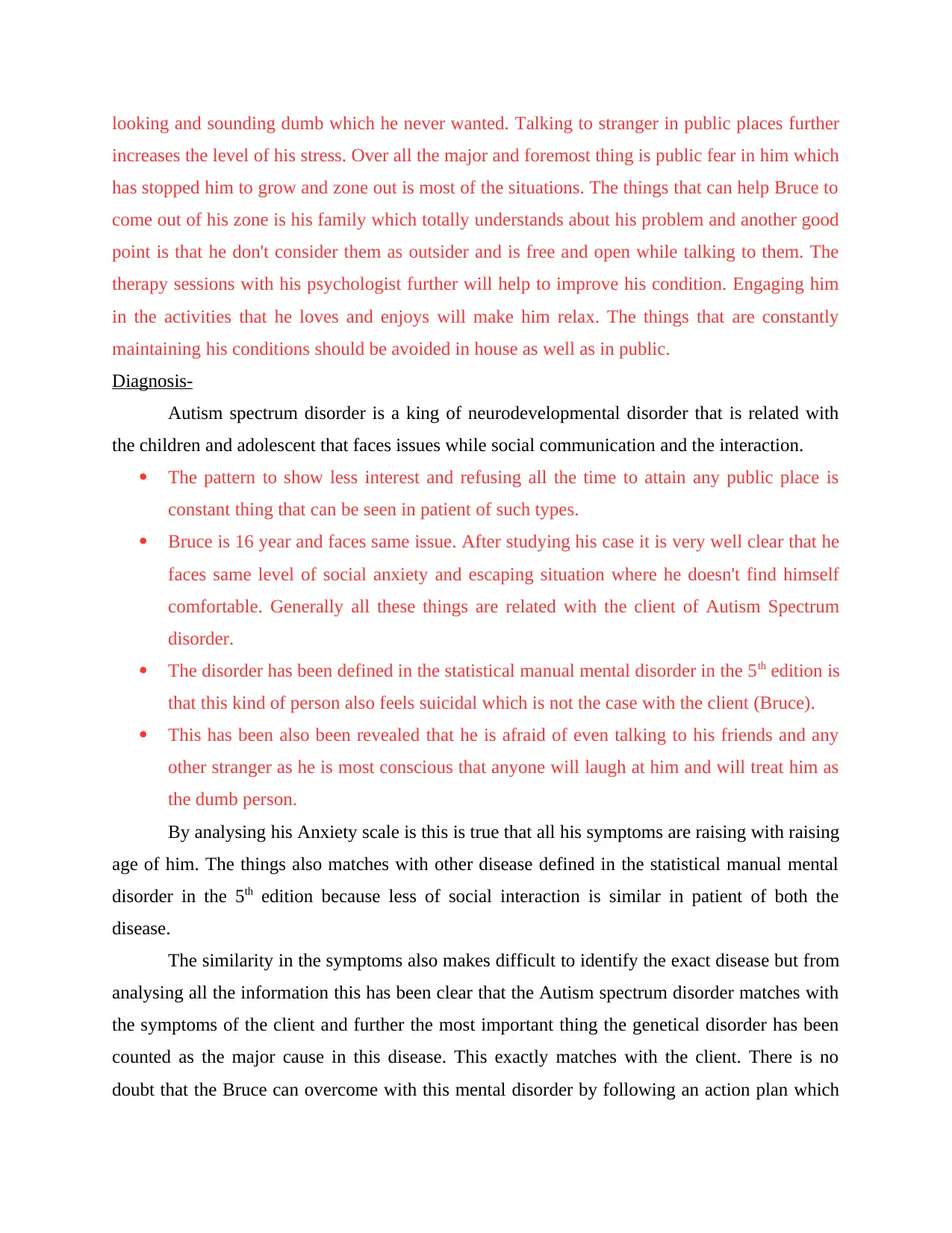
looking and sounding dumb which he never wanted. Talking to stranger in public places further
increases the level of his stress. Over all the major and foremost thing is public fear in him which
has stopped him to grow and zone out is most of the situations. The things that can help Bruce to
come out of his zone is his family which totally understands about his problem and another good
point is that he don't consider them as outsider and is free and open while talking to them. The
therapy sessions with his psychologist further will help to improve his condition. Engaging him
in the activities that he loves and enjoys will make him relax. The things that are constantly
maintaining his conditions should be avoided in house as well as in public.
Diagnosis-
Autism spectrum disorder is a king of neurodevelopmental disorder that is related with
the children and adolescent that faces issues while social communication and the interaction.
The pattern to show less interest and refusing all the time to attain any public place is
constant thing that can be seen in patient of such types.
Bruce is 16 year and faces same issue. After studying his case it is very well clear that he
faces same level of social anxiety and escaping situation where he doesn't find himself
comfortable. Generally all these things are related with the client of Autism Spectrum
disorder.
The disorder has been defined in the statistical manual mental disorder in the 5th edition is
that this kind of person also feels suicidal which is not the case with the client (Bruce).
This has been also been revealed that he is afraid of even talking to his friends and any
other stranger as he is most conscious that anyone will laugh at him and will treat him as
the dumb person.
By analysing his Anxiety scale is this is true that all his symptoms are raising with raising
age of him. The things also matches with other disease defined in the statistical manual mental
disorder in the 5th edition because less of social interaction is similar in patient of both the
disease.
The similarity in the symptoms also makes difficult to identify the exact disease but from
analysing all the information this has been clear that the Autism spectrum disorder matches with
the symptoms of the client and further the most important thing the genetical disorder has been
counted as the major cause in this disease. This exactly matches with the client. There is no
doubt that the Bruce can overcome with this mental disorder by following an action plan which
increases the level of his stress. Over all the major and foremost thing is public fear in him which
has stopped him to grow and zone out is most of the situations. The things that can help Bruce to
come out of his zone is his family which totally understands about his problem and another good
point is that he don't consider them as outsider and is free and open while talking to them. The
therapy sessions with his psychologist further will help to improve his condition. Engaging him
in the activities that he loves and enjoys will make him relax. The things that are constantly
maintaining his conditions should be avoided in house as well as in public.
Diagnosis-
Autism spectrum disorder is a king of neurodevelopmental disorder that is related with
the children and adolescent that faces issues while social communication and the interaction.
The pattern to show less interest and refusing all the time to attain any public place is
constant thing that can be seen in patient of such types.
Bruce is 16 year and faces same issue. After studying his case it is very well clear that he
faces same level of social anxiety and escaping situation where he doesn't find himself
comfortable. Generally all these things are related with the client of Autism Spectrum
disorder.
The disorder has been defined in the statistical manual mental disorder in the 5th edition is
that this kind of person also feels suicidal which is not the case with the client (Bruce).
This has been also been revealed that he is afraid of even talking to his friends and any
other stranger as he is most conscious that anyone will laugh at him and will treat him as
the dumb person.
By analysing his Anxiety scale is this is true that all his symptoms are raising with raising
age of him. The things also matches with other disease defined in the statistical manual mental
disorder in the 5th edition because less of social interaction is similar in patient of both the
disease.
The similarity in the symptoms also makes difficult to identify the exact disease but from
analysing all the information this has been clear that the Autism spectrum disorder matches with
the symptoms of the client and further the most important thing the genetical disorder has been
counted as the major cause in this disease. This exactly matches with the client. There is no
doubt that the Bruce can overcome with this mental disorder by following an action plan which
⊘ This is a preview!⊘
Do you want full access?
Subscribe today to unlock all pages.

Trusted by 1+ million students worldwide
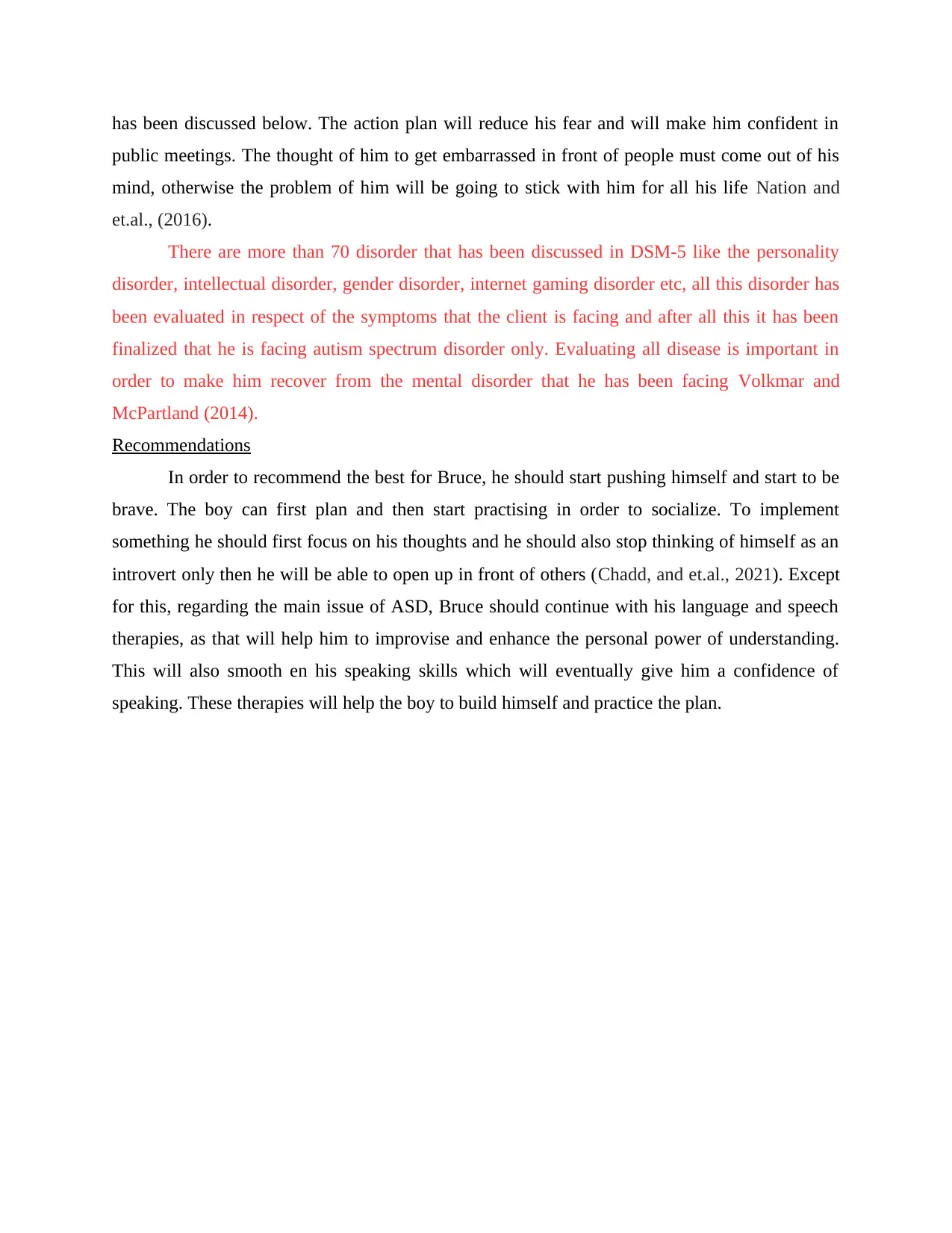
has been discussed below. The action plan will reduce his fear and will make him confident in
public meetings. The thought of him to get embarrassed in front of people must come out of his
mind, otherwise the problem of him will be going to stick with him for all his life Nation and
et.al., (2016).
There are more than 70 disorder that has been discussed in DSM-5 like the personality
disorder, intellectual disorder, gender disorder, internet gaming disorder etc, all this disorder has
been evaluated in respect of the symptoms that the client is facing and after all this it has been
finalized that he is facing autism spectrum disorder only. Evaluating all disease is important in
order to make him recover from the mental disorder that he has been facing Volkmar and
McPartland (2014).
Recommendations
In order to recommend the best for Bruce, he should start pushing himself and start to be
brave. The boy can first plan and then start practising in order to socialize. To implement
something he should first focus on his thoughts and he should also stop thinking of himself as an
introvert only then he will be able to open up in front of others (Chadd, and et.al., 2021). Except
for this, regarding the main issue of ASD, Bruce should continue with his language and speech
therapies, as that will help him to improvise and enhance the personal power of understanding.
This will also smooth en his speaking skills which will eventually give him a confidence of
speaking. These therapies will help the boy to build himself and practice the plan.
public meetings. The thought of him to get embarrassed in front of people must come out of his
mind, otherwise the problem of him will be going to stick with him for all his life Nation and
et.al., (2016).
There are more than 70 disorder that has been discussed in DSM-5 like the personality
disorder, intellectual disorder, gender disorder, internet gaming disorder etc, all this disorder has
been evaluated in respect of the symptoms that the client is facing and after all this it has been
finalized that he is facing autism spectrum disorder only. Evaluating all disease is important in
order to make him recover from the mental disorder that he has been facing Volkmar and
McPartland (2014).
Recommendations
In order to recommend the best for Bruce, he should start pushing himself and start to be
brave. The boy can first plan and then start practising in order to socialize. To implement
something he should first focus on his thoughts and he should also stop thinking of himself as an
introvert only then he will be able to open up in front of others (Chadd, and et.al., 2021). Except
for this, regarding the main issue of ASD, Bruce should continue with his language and speech
therapies, as that will help him to improvise and enhance the personal power of understanding.
This will also smooth en his speaking skills which will eventually give him a confidence of
speaking. These therapies will help the boy to build himself and practice the plan.
Paraphrase This Document
Need a fresh take? Get an instant paraphrase of this document with our AI Paraphraser
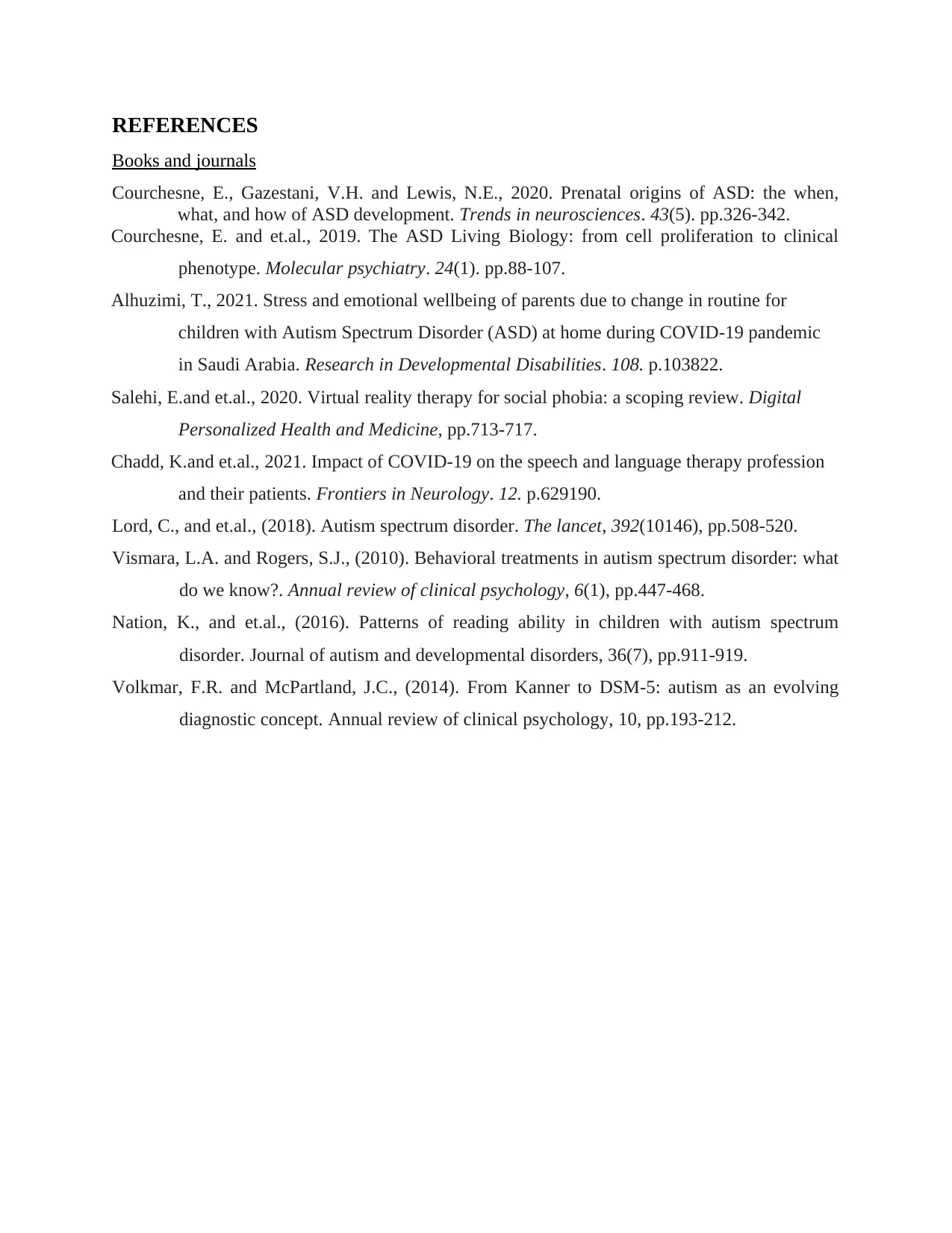
REFERENCES
Books and journals
Courchesne, E., Gazestani, V.H. and Lewis, N.E., 2020. Prenatal origins of ASD: the when,
what, and how of ASD development. Trends in neurosciences. 43(5). pp.326-342.
Courchesne, E. and et.al., 2019. The ASD Living Biology: from cell proliferation to clinical
phenotype. Molecular psychiatry. 24(1). pp.88-107.
Alhuzimi, T., 2021. Stress and emotional wellbeing of parents due to change in routine for
children with Autism Spectrum Disorder (ASD) at home during COVID-19 pandemic
in Saudi Arabia. Research in Developmental Disabilities. 108. p.103822.
Salehi, E.and et.al., 2020. Virtual reality therapy for social phobia: a scoping review. Digital
Personalized Health and Medicine, pp.713-717.
Chadd, K.and et.al., 2021. Impact of COVID-19 on the speech and language therapy profession
and their patients. Frontiers in Neurology. 12. p.629190.
Lord, C., and et.al., (2018). Autism spectrum disorder. The lancet, 392(10146), pp.508-520.
Vismara, L.A. and Rogers, S.J., (2010). Behavioral treatments in autism spectrum disorder: what
do we know?. Annual review of clinical psychology, 6(1), pp.447-468.
Nation, K., and et.al., (2016). Patterns of reading ability in children with autism spectrum
disorder. Journal of autism and developmental disorders, 36(7), pp.911-919.
Volkmar, F.R. and McPartland, J.C., (2014). From Kanner to DSM-5: autism as an evolving
diagnostic concept. Annual review of clinical psychology, 10, pp.193-212.
Books and journals
Courchesne, E., Gazestani, V.H. and Lewis, N.E., 2020. Prenatal origins of ASD: the when,
what, and how of ASD development. Trends in neurosciences. 43(5). pp.326-342.
Courchesne, E. and et.al., 2019. The ASD Living Biology: from cell proliferation to clinical
phenotype. Molecular psychiatry. 24(1). pp.88-107.
Alhuzimi, T., 2021. Stress and emotional wellbeing of parents due to change in routine for
children with Autism Spectrum Disorder (ASD) at home during COVID-19 pandemic
in Saudi Arabia. Research in Developmental Disabilities. 108. p.103822.
Salehi, E.and et.al., 2020. Virtual reality therapy for social phobia: a scoping review. Digital
Personalized Health and Medicine, pp.713-717.
Chadd, K.and et.al., 2021. Impact of COVID-19 on the speech and language therapy profession
and their patients. Frontiers in Neurology. 12. p.629190.
Lord, C., and et.al., (2018). Autism spectrum disorder. The lancet, 392(10146), pp.508-520.
Vismara, L.A. and Rogers, S.J., (2010). Behavioral treatments in autism spectrum disorder: what
do we know?. Annual review of clinical psychology, 6(1), pp.447-468.
Nation, K., and et.al., (2016). Patterns of reading ability in children with autism spectrum
disorder. Journal of autism and developmental disorders, 36(7), pp.911-919.
Volkmar, F.R. and McPartland, J.C., (2014). From Kanner to DSM-5: autism as an evolving
diagnostic concept. Annual review of clinical psychology, 10, pp.193-212.

⊘ This is a preview!⊘
Do you want full access?
Subscribe today to unlock all pages.

Trusted by 1+ million students worldwide
1 out of 9
Your All-in-One AI-Powered Toolkit for Academic Success.
+13062052269
info@desklib.com
Available 24*7 on WhatsApp / Email
![[object Object]](/_next/static/media/star-bottom.7253800d.svg)
Unlock your academic potential
Copyright © 2020–2025 A2Z Services. All Rights Reserved. Developed and managed by ZUCOL.
